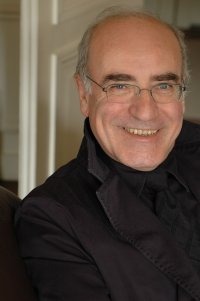Claude Jeancolas
This article has multiple issues. Please help improve it or discuss these issues on the talk page. (Learn how and when to remove these messages)
|
Claude Jeancolas | |
|---|---|
 | |
| Born | June 10, 1949 |
| Died | February 10, 2016 (aged 66) |
| Occupation | Journalist, writer, art historian |
| Nationality | French |
Claude Jeancolas (June 10, 1949 – February 10, 2016) was a French writer, art historian, and journalist.[1] He is best known for his work on Arthur Rimbaud.[2][3]
Life
[edit]Jeancolas spent his childhood and adolescence in Nancy, in the east of France.[4] At the age of 16, he left for Paris with his Baccalaureate diploma. There, he continued his studies in a preparatory class for the "grandes écoles", and later entered the École Supérieure de Commerce of Paris (ESCP). He earned a degree from the Business School of the University of Texas where he wrote his thesis on the management of the American press. He was a visiting scholar at various American universities, including UCLA, Stanford University, the University of California at Berkeley, San Francisco State University, the School of Journalism in Columbia Missouri, and Columbia University in New York. He passed away on 17 February 2016.[5]
Journalism career
[edit]Jeancolas began his career as the head of the financial analysis department of the weekly magazine Entreprise. He then founded two management journals: Enseignement et gestion and Revue Française de Gestion. Following that, he became the head of the avant-garde monthly Mode international. He later edited the magazines Collections, Décoration, and Mariages. He moved to Votre Beauté, a magazine that François Mitterrand edited early in his career. Jeancolas then joined the Hachette Group (now the Lagardère Group) as the international editor of Elle[1] (which saw four editions created worldwide) and Elle Décoration (which saw 14 editions created worldwide). He also created Cousteau Junior and Max. Until 2012, he was the director of Marie Claire maison and Marie Claire travel magazines in Milan.
Art historian career
[edit]His interest in art developed in 1969 after meeting the sculptor Edmond Moirignot, with whom he became a close friend and later the guardian and executor of his will. In 1987, he published a monograph on the sculptor Jean-Baptiste Carpeaux. Following this publication, Jeancolas studied the history of sculpture and French drawing. He later[citation needed] published two books on the Nabis and the Fauves.
Rimbaud
[edit]After quoting Arthur Rimbaud to his professor Izambard in an editorial for Max, Jeancolas received an overwhelming amount of mail, which prompted him to explore the subject further. He continued to study Rimbaud's work and regularly published on the topic. In his view, Rimbaud was too intelligent (he was at the top of his class)[6] to be incoherent. Jeancolas argued that Rimbaud's poems always carried meaning, were coherent, and served a purpose.[citation needed] He also wrote about Une Saison en enfer. Additionally, he attempted to redeem the poet's highly criticized mother, Vitalie Rimbaud, in a biography that alimed to demonstrate the intense love she had for her child and her importance to Rimbaud.
Bibliography
[edit]Main publications:
- 1985
- Moirignot. Éditions du St Gothard. Paris
- 1987
- Carpeaux peintre et sculpteur. Edita. Lausanne
- 1991
- La Sculpture italienne du XXe siècle. Éditions Van Wilder. Paris
- Les Voyages de Rimbaud. Balland. Paris
- Le Dictionnaire Rimbaud. Balland. Paris
- 1993
- La Sculpture française. Fabbri. Milan
- 1995
- Le Dessin en France de la renaissance au XXe siècle. Rizzoli. Milan
- 1996
- L'œuvre intégrale manuscrite de Rimbaud. Textuel. Paris
- 1997
- Le Don du père. Flammarion. Paris
- Les Lettres manuscrites de Rimbaud. Textuel. Paris
- 1998
- Lettres et poèmes de Rimbaud. L'auberge verte. Paris
- Une saison en enfer de Rimbaud. Hachette. Paris
- Passion Rimbaud. Textuel. Paris
- 1999
- Poésies de Rimbaud. Éditions mille et une nuits. Paris
- Rimbaud, la biographie. Flammarion. Paris
- Venise et ses peintres. Une histoire intime. Éditions Van Wilder. Paris
- L'Afrique de Rimbaud. Textuel. Paris
- 2000
- Rimbaud, l'œuvre. Textuel. Paris
- 2002
- La Peinture des Nabis. Éditions fvw. Paris
- 2004
- Vitalie Rimbaud, pour l'amour d'un fils. biographie. Flammarion
- Rimbaud après Rimbaud, anthologie. Textuel. Paris
- 2005
- Rimbaud, l'œuvre, la vie. Éditions France Loisirs
- 2006
- Les Fauves, couleurs et lumières. Éditions FVW. Paris
- Moirignot, la vie, l'œuvre, le catalogue raisonné. Éditions FVW. Paris
- 2007
- Le regard bleu d'Arthur Rimbaud. Éditions FVW. Paris
- 2008 in collaboration
- Fierté de fer with Joël Alessandra et Idriss Youssouf Elmi. Éditions Paquet. Genève
- L'aube du monde with Thibaut et Pascal Villecroix, Amina Saïd Chiré - FVW. Paris
- 2008
- Le Retour à Tadjoura – l'Afrique secrète de Jean-François Deniau – FVW. Paris
Many of these have been translated into German, Korean, Japanese and English.
References
[edit]- ^ a b Giovannini, Joseph (28 April 1988). "CURRENTS; Decoration Tries a New Accent". The New York Times. Retrieved 24 December 2010.
- ^ "A Charleville, Rimbaud puissance 50". L'Union (in French). 8 January 2008. Retrieved 24 December 2010.
- ^ "Avec la mort de Claude Jeancolas, Arthur Rimbaud perd un de ses plus grands connaisseurs". lunion. Archived from the original on 19 February 2016.
- ^ "Avec la mort de Claude Jeancolas, Arthur Rimbaud perd un de ses plus grands connaisseurs". Journal L'Union (in French). 18 February 2016. Retrieved 17 December 2024.
- ^ "Avec la mort de Claude Jeancolas, Arthur Rimbaud perd un de ses plus grands connaisseurs". Lunion.fr. Archived from the original on 19 February 2016. Retrieved 20 February 2016.
- ^ "Arthur Rimbaud | The Letters (1870-1872)". BLACKOUT ((poetry & politics)). 3 March 2019. Retrieved 2 December 2024.
